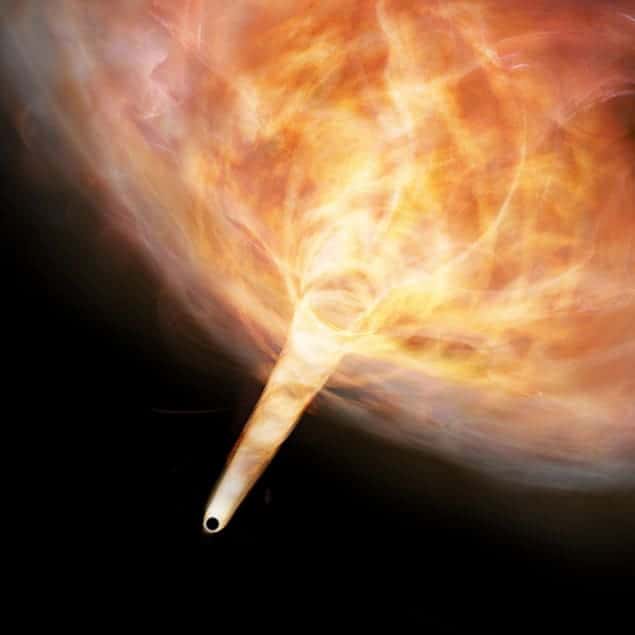Flash Physics is our daily pick of the latest need-to-know developments from the global physics community selected by Physics World‘s team of editors and reporters

Cosmic bullet may be a stray black hole
A stray black hole is thought to be bursting out of a supernova remnant. While studying supernova remnant SNR W44, scientists at Keio University in Japan may have stumbled across a wandering black hole. SNR W44 is 10,000 light-years away from Earth and surrounded by an expanding cloud of molecular gas. Masaya Yamada and colleagues were examining the energy-transfer processes of W44’s supernova explosion when they observed an object at the cloud’s edge travelling 100 times faster than the speed of sound in interstellar space. The object, which they named the “Bullet”, is moving against the Milky Way’s rotation and appears to be shooting out of the SNR trailed by gas. Using data from the Nobeyama Radio Observatory and the Atacama Submillimeter Telescope Experiment, the researchers found the Bullet had immense kinetic energy that could not be accounted for by the supernova explosion. Writing in The Astrophysical Journal Letters, Yamada and colleagues propose two models involving a black hole to explain the unusual phenomenon. In their “explosion model” there is an additional explosion event near the expanding gas cloud. They propose that the SNR W44 passes a static black hole that pulls the gas closer and causes an explosion. The gas is then accelerated away once the cloud has passed the black hole. Alternatively, there is the “shooting model”. In this case a wandering, high-speed black hole travels through the dense cloud, pulling gas along behind it. The team hopes further analysis will make it clearer which scenario is occurring. The finding may also help to observe other stray black holes that have been predicted to exist within the Milky Way.
New wind turbine is designed for urban use

A new wind turbine for domestic and small-scale commercial use has been developed by the European SWIP programme – which is funded by the European Union (EU) and involves companies, institutes and universities in 10 EU countries. According to SWIP, the turbine is up to 20% more efficient at generating electricity in wind conditions commonly found in urban environments. One important feature of the turbine’s blades is that their tips are wider than on those found on other small turbines. According to Fernando Aznar of Solute – a Spain-based wind-energy engineering firm – the wider tips improve the aerodynamic performance of the blades while reducing noise and vibrations. Making a quiet turbine is an important goal of SWIP because the systems will operate in populated areas. The turbine also has a new control system that adjusts the pitch of the blades to maximize efficiency. This system is passive – with changes being driven by the blades themselves – which Aznar says is decreases the total cost of the turbine and protects it from damage. Lin Ma of the University of Sheffield developed computer models of the turbine and says that “the new blade design takes consideration of the performance, noise, aesthetic aspect, the cost of manufacturing of the turbine and the long term operational and maintenance costs.” The turbine’s electrical generator was developed by the Spanish company 4fores. “The challenge was to obtain a permanent magnet synchronous generator that operates at lower rotational speeds than currently used generators, while maintaining benchmark size, power and efficiency, and keeping cost at a low level,” says Jorge Herrero Ciudad of 4fores. One problem that plagues the low-speed operation common in urban areas is “cogging torque”. This is caused by magnetic interactions within the generator and results in the jerking of blade rotation. The SWIP generator was designed to minimize cogging torque, which allows it to produce energy even while running at low speeds. The turbines are also 50% lighter than conventional design because aluminium is used in place of steel. This reduces the cost of installing the turbines because the supporting tower does not have to be as substantial. There is more about the SWIP turbine in “Wind turbines head for homes again“.
Mark Walport to lead new UK science agency

Mark Walport, the UK government’s chief scientific adviser, has been appointed the first chief executive of UK Research and Innovation – a new umbrella organization that will oversee the country’s seven research councils. The UKRI, which will be responsible for £6bn in research grants and funding each year, is expected to be created when the higher-education and research bill passes through parliament later this year. In addition to the seven research councils, which include the Science and Technology Facilities Council and the Engineering and Physical Sciences Research Council, the UKRI will also include Innovate UK – a public body that works with companies to boost innovation – as well as some functions of the Higher Education Funding Council for England. “My ambition is to make UKRI the world’s leading research-and-innovation public funding agency,” says Walport. If the UKRI gets the go ahead it is expected to begin operation in early-2018.
- You can find all our daily Flash Physics posts in the website’s news section, as well as on Twitter and Facebook using #FlashPhysics.



